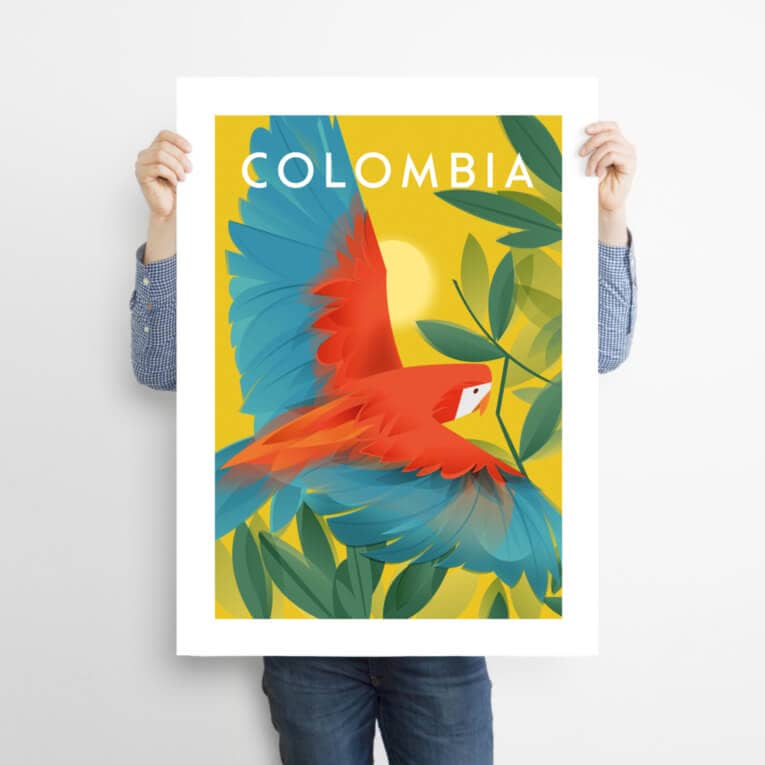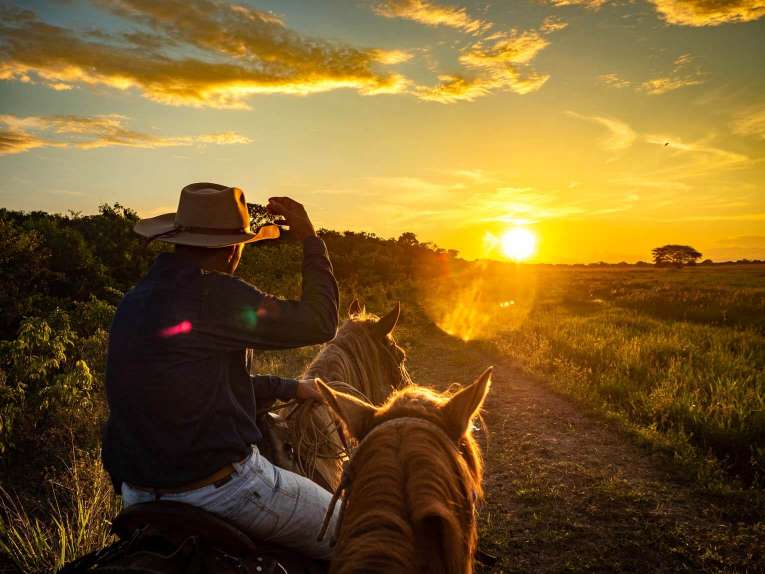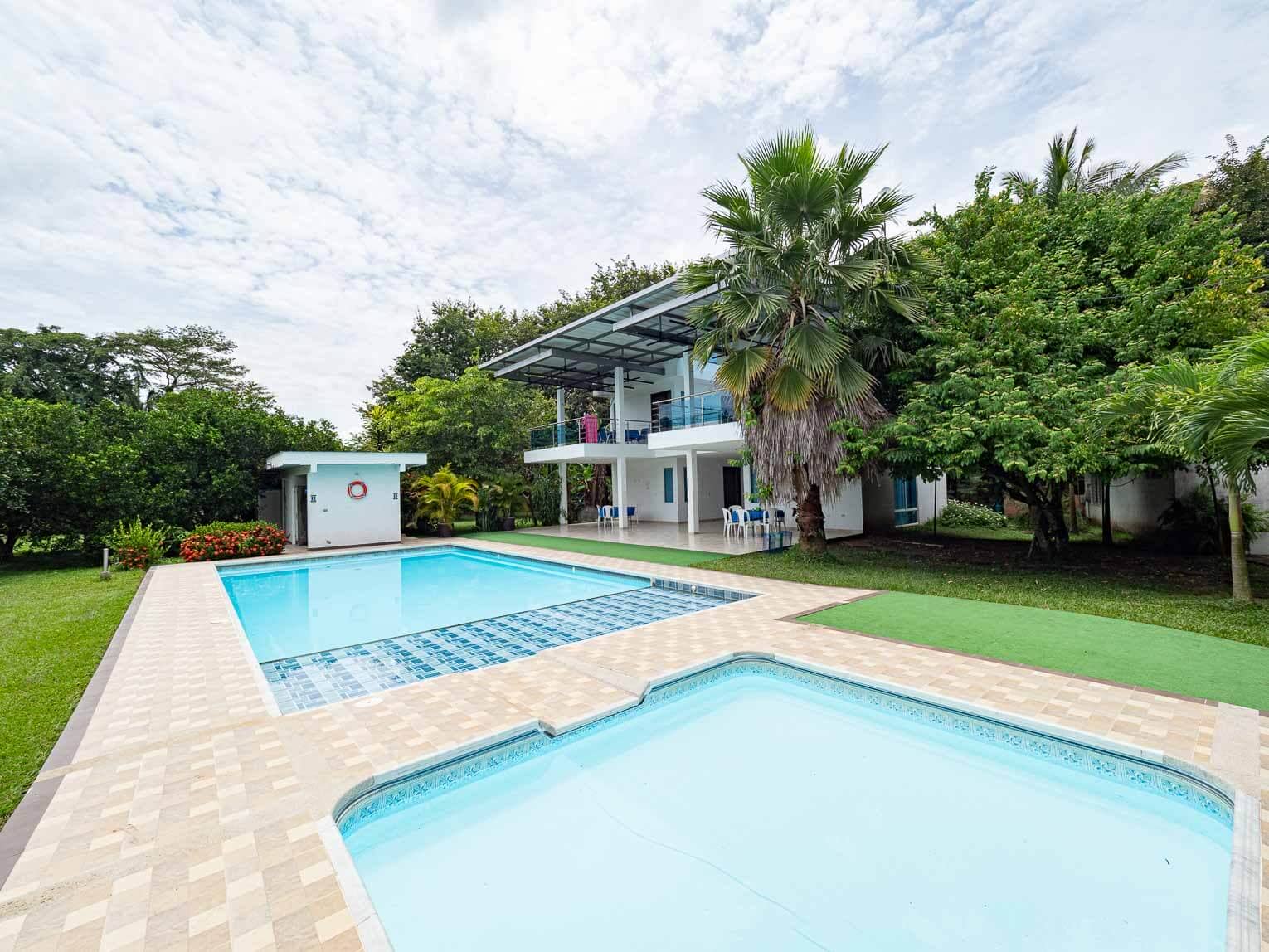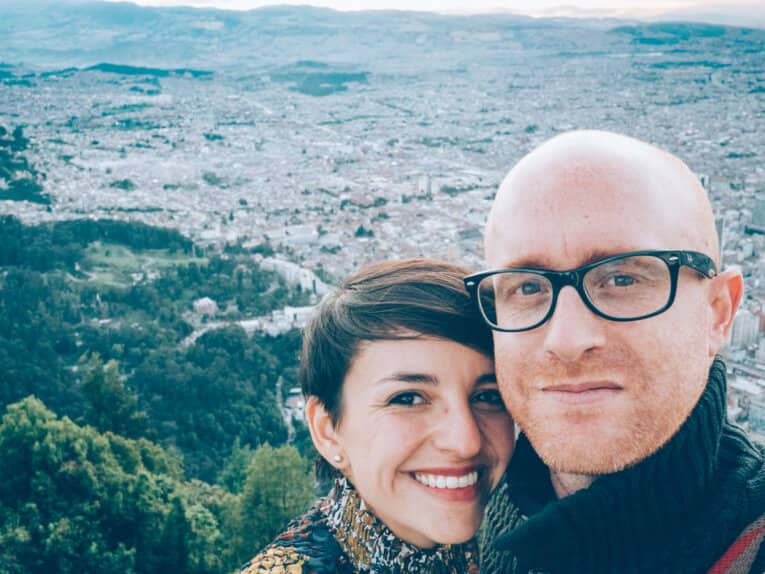We can say that we had the privilege of visiting Casanare, a little-known region of Colombia for which we had always been curious and interested. Was it due to Angélica’s love of llanera music from an early age? Was it Luis Ariel Rey’s song “Ay si si”? Was it the mythical sunsets that every Colombian has heard of?
In any case, when we had the oportunity to go to Casanare, we applauded with both hands.
So here’s the story of our 3-day immersion in the heart of the Casanare’s landscapes and llanera culture, accompanied by our super guide Geiler!
Contents
Related posts

Travel Poster “Guacamaya”
Buy our beautiful prints to get a taste of Colombia at home
Disclaimer: we apologize in advance for any grammatical or syntactic errors, as our native language is not English (we're a Colombian-French couple), so we hope you'll forgive us and still enjoy the information we share with you! Please note that all the information on our blog is based on our own experience, and is checked and updated regularly.
Visit the Casanare: a Llanero Safari
A favorite

If you’ve been following our travel blog for a while, you’ll know by now that Colombia has a remarkable diversity of landscapes, cultures and traditions.
The Llanos region is certainly one of those where landscape and culture have a place of their own, totally different from the rest of the country. Long isolated by the lack of roads and infrastructure to access it, the Llanos region has developed its own identity. Here, you’ll discover traditions, a blend of influences and an abundance of natural heritage !
During our three-day stay in Casanare, our guide Heiler introduced us to three Hatos around the villages of Trinidad and San Luis de Palenque: Hato Berlin, Hato Las Gaviotas and Hato Los deseos. We’ll be writing specific posts on each Hatos with more photos and details soon, but in this post we’ll explain what a Hato is anyway.
Wildlife watching
Today we understand better why these three days were marked by what they call locally a “Llanero Safari”. Safari here, of course, simply means the opportunity to observe animals in their natural environment.
To tell you the truth, although our taste for llanera music meant that we knew a little about Llano culture, we were really surprised to see the impressive amount of wild fauna that could be observed in the Casanare:
- Chigüiros (Cabiaï)
- Spectacled caimans, Iguanas, Water turtles
- Anteaters
- Howler monkeys
- Hinds (yes, yes!)
- Herons, Pink Ibises, Great Egrets, Pink Spoonbills
- Toucans, Burrowing Owls, Kingfishers, Hummingbirds, Cardinal,
- Etc. etc.














Who is Le Casanare for?
A stay in the Casanare is truly an opportunity to witness a truly exceptional cultural and natural wealth.
- For everyone: it’s a safe and secure region where you can come alone, as a couple, with friends or family.
- For nature and animal lovers: as you’ve seen, the diversity of wildlife here is impressive
- For horse lovers: this is your chance to indulge your passion in a region where the horse plays a central role
- For wildlife photographers: this is truly a little paradise.
- For lovers of cultural encounters: discussions, music, dance, traditions, it’s all here!
As an aside, Heiler was a darling of a guide! Rarely have we been so pampered during a trip, and rarely have we had to deal with someone so passionate and dedicated… thanks to him, we learned an enormous amount, but above all he was able to pass on to us his love for his land and his desire for travellers to come and discover this Casanare that has so much to offer. So we promised him you’d come and see him soon!
Contact Heiler to visit Casanare
Our Llanero Safari program
Visit the Casanare
Heiler told us:“You’ll see, each Hato is really different. Each one has its own specificities, its own universe, its own landscapes and its own ecosystem“. Well, he was right!
Day 1 – Hato Berlin
MORNING
- Flight Bogota – Yopal with Clicair
- Arrive in Yopal late morning after a long delay.
- Transfer by 4×4 to Hato Berlin with Heiler our guide and Jesus our driver
- Lunch at Hato Berlin (Trinidad)
AFTERNOON
- Siesta
- Short walk to discover the local fauna
- Canoe trip to watch the sun set and the herons gather in their favourite tree.
- Overnight in San Luis de Palenque
Day 2 – El Llanerazo Museum and Hato Las Gaviota
MORNING
- Transfer by Lancha on the Río Pauto to Casa Museo El Llanerazo
- Meet Seudiel “El Llanerazo” and learn about llanera culture
- Lunch with Seudiel
AFTERNOON
- 4×4 transfer to Hato Las Gaviotas (San Luis de Palenque)
- Horseback ride to discover the interior of a “Garcero” and its thousands of herons
- Return to the farm as the sun sets
- Overnight in San Luis de Palenque
Day 3 – Hato Los Deseos
MORNING
- Meeting with local musicians
- 4×4 transfer to Hato Los Deseos (Trinidad)
- Lunch at Hato Los Deseos
AFTERNOON
- Siesta
- Horseback ride through the fields to observe local wildlife
- Transfer to Yopal
- Overnight in Yopal
Contact Heiler to visit Casanare
The Llanero: the Colombian cowboy
Visit the Casanare

Livestock farming has always been the main activity in the Casanare region. Colombian farmers have invested these immense plains to build gigantic farms of several thousand hectares called Hatos.
On these immense plains, the horse is the primary working tool for fetching and rounding up the herds. Hats, shirts, jeans, lassoes and boots are the traditional attire of the llanero.
Competitions of all kinds are regularly organized to select the region’s best llaneros: on the program are rodeos, lasso-handling contests, “coleo”, which consists of grabbing a cow by the tail and then successfully dropping it, milking, traditional dances and music, cantos de vaqueria, etc.
We were lucky enough to meet Seudiel, the “llanerazo” winner of one of the only competitions for the best llanero of 2010, a competition that at the time lasted 15 days and literally involved all farm work. Today, Seudiel is dedicated to maintaining the llanera tradition through his “house museum“, where he shares the knowledge and traditions he learned as a child, and which with the arrival of modernity are tending to be lost.







With his own hands, Seudiel has built a reconstruction of everything that made traditional Hatos so special, to keep the memory alive. But far from being a dusty museum, this is his living space, where he welcomes travellers over a meal and discussions about llanera culture. A fascinating experience!
The visit ends with a demonstration of the technical mastery of the llanero rider, who must be able to cross a river with his horse in order to guide the herd. Seudiel mounts his horse barefoot, held by a simple rope without fittings, and descends into the river. He swims across, guiding his faithful steed like a master, and climbs back up proudly as if nothing had happened: impressive!
Contact Heiler to visit Casanare
The Hatos
Visit the Casanare

Originally, a Hato was a farm with a surface area of over 1.000 ha and over 250.000 head of cattle… you heard right!
Thanks to the total absence of construction and human presence, Hatos have acted as immense nature reserves, often boasting an astonishing biodiversity that today makes them a real tourist attraction.
But Hatos are first and foremost cattle farms. These farms operated in total autonomy and employed a huge number of workers.
It has to be said that at the time these lands were exploited, there was nothing but savannah as far as the eye could see, declared “Tierra Brava“. Each farmer was free to set up his cabin, raise his cows in the wild, then clear the land around it and extend his domain ad infinitum until he met another farmer and decided on an imaginary boundary between the two properties.







Free-range cattle could travel for miles, which is why more cabins were built all over the property. These houses served as landmarks on the property boundaries, allowing riders in search of cattle to stop and rest. This sometimes meant riding for days!
Another fun fact: the “Ley del llano” allowed anyone who came across an unmarked cow to claim it as their own if they managed to lasso it.
Although the size of the Hatos at Casanare has shrunk, they are still huge properties that one might expect to be used for industrial breeding. However, this is not the case at all.





Livestock farming in the llanos is still practiced in a traditional and basic way: cows are raised in the wild on immense pastures, fed only grass and salt, without the addition of drugs or other growth hormones.
With 8 th of all cattle raised in Colombia, the Casanare raises over 15 million cows on its territory.
Contact Heiler to visit Casanare
Music and dance
Visit the Casanare

To finish with a look at llanera culture, it was impossible not to mention the main marker of local tradition: music and dance. How can we talk about Casanare without mentioning Joropo?
Joropo has become Colombia’s national heritage and the essence of the llanera identity. The origin of the word “Joropo” is dubious: some attribute it to Arabic, others to the language spoken locally by the indigenous people.
The Joropo: singing
If our guide Heiler is to be believed, singing has always served the llanero on horseback to combat loneliness. Alone for hours or even days on his horse, the rider sings odes to the work of the cattle, to nature and, of course, to women.
We hear a certain nostalgia, that of a woman who misses her home, that of a surrounding nature that dazzles, that of the love of this land that is both so beautiful and so hard to work… The Joropo is a concentrate of this tradition.
Joropo: music
As is often the case in Colombia, llanera music is a blend of European, African and indigenous influences. Traditionally, Joropo is played on 3 main instruments: the harp, cuatro and maracas. Today, the harp is the king instrument, playing the melody. Based on a 3-beat rhythm and fast tempos, it’s easy to find in it the resonance of rhythms we’re more familiar with in Europe, such as the Fandango.
On the last day of our tour of Casanare, Heiler organizes an impromptu meeting with the Higuera family, a family of local musicians whose group is called Cunaguaro. They perform at local festivals and parties. The father, on guitar, has passed on his passion to his children, his son plays the harp and his daughter sings with a striking voice! The group performs a few songs from their repertoire, and we chat with them about tradition and what makes them so fond of llanera music.






Joropo dance
The Joropo dance has its roots in European dances, the waltz, Andalusian dances and Flamenco. In particular, the Joropo features the famous “Zapateo“, the rhythmic footwork typical of flamenco dance. You can also imagine the link between the sound of heels on the floorboards and that of a horse’s hooves.
Joropo is danced as a couple, and there are many theories about the roles of men and women. Some imagine that the woman is there to support the man, to help him overcome his hard daily work.
One evening, we were lucky enough to attend a Joropo dance competition by local children in Trinidad‘s central square. It was very moving to see these little ones defending this tradition as hard as they could. The square was packed with people, showing how the tradition lives on, even though Heiler kept telling us that today’s young people were beginning to lose interest in llanera culture.






Cantos de vaqueria (cowherd songs)
Now part of Colombia’s intangible heritage, cantos de vaqueria are very special songs for talking to the herd.
They were used by cowboys to call the herd together, or to calm them when they were frightened, as when they had to swim across a river, for example.
Today, practices have changed with the times, and these songs are less widely used, but remain rooted in llanero tradition.
Contact Heiler to visit Casanare
Peacetime tourism
Visit Casanare

Like many regions of Colombia, Casanare has lived through dark times, mainly linked to paramilitarism (AUC). It wasn’t until the dismantling of these far-right militias in 2006 that the Casanare began to turn the corner. Residents were able to return to their homes, resume their activities and live a “normal” life.
Today, tourism has a major role to play in the department’s development.
The Casanare is at the heart of programs to build a culture around tourism and peace. The aim is to generate value chains and improve the quality of life of host communities through responsible and sustainable practices.
Since the signing of the peace accords, Heiler and other local tourism players have been working to develop responsible tourism in Casanare. Heiler confides that the mission is not an easy one, and that people don’t fully understand the benefits of developing tourism. He explains that it took him some time to convince the families of the various Hatos that there was an opportunity for them to diversify their income and showcase the beauty of their land and culture.
Contact Heiler to visit Casanare
Sunset on the Casanare
Summing up our experience

The reason we learned so much, and can tell you so much today, is that throughout these 3 days, Heiler, our guide, shared his passion for his land and culture with us. Every day he sang something to us as we rode along, and what a beautiful memory it was to hear him, proud on his horse, as evening fell, singing to us of the beauty of a sunset over his beloved llano..
Quite simply, it was a magical experience.
Magical, that’s the word.
This immersion in the Casanare was a real treat for our little traveling hearts. We were totally surprised by the richness of these three days, between cultural discoveries and observation of an extremely rich fauna! Heiler, our guide, concocted a program just for us, always ready to listen, always looking after the smallest details. Every day after the walks, a limonada was waiting for us, a little something to eat, the pace was adapted to the weather, the temperatures, our desires… In short, exceptional service !
Thanks for everything Heiler!
To spend 3 days in the Casanare is to offer yourself an unexpected interlude in your trip to Colombia, and to support responsible, community-based tourism that works for post-conflict peace.











Contact Heiler to visit the Casanare
The Casanare is a region that is difficult to visit without a local guide : the roads are mostly dirt tracks requiring a 4×4 vehicle, and the Hatos are private property where you need to know the people.
The result is a region that requires a certain budget to enjoy a simply unforgettable experience!
To book a Llanero Safari, you can get in direct contact with Heiler using our form, which arrives directly in his mailbox!
Where to stay in Yopal
Yopal

Hotel
Villa Lisseth
Double room : $150.000 to $200.000 COP
A hotel where we stayed in Yopal at the end of our return from Safari Llanero. A nice place in a quiet area of town, in a pretty garden with a swimming pool, large, clean and modern rooms, and a very warm welcome from the staff!
When to visit Casanare
The seasons in the Casanare region are very marked, leading to changes in the landscape and the way you visit it.
Dry season
Between January and March, the whole plain is completely dry, the streams diminish, the lakes diminish and the wildlife concentrates around the few existing water points. The “Moriche” or “Morichal” palms are one of the key elements in the preservation of the “flooded savannah” ecosystems that retain water during the dry season.
During this period, Hatos can be explored on foot or by 4×4. Please note, however, that some activities are not possible due to the lack of water.
Rainy season
From May to October is the rainy season, when the rivers swell and some parts of the plains are flooded. This is when the abundance of wildlife is at its most spectacular. There’s a peak in June and July, when the rains are heaviest and the plains are almost completely flooded.
During this period, the Hatos are best explored on horseback or by boat.
We went to the Casanare in September 2019 and that year we were in the intermediate period when part of the plains were flooded, but not totally.
Transitional season
April, November and December are transitional months.
How to get to Casanare
The capital of the Casanare is Yopal, the starting point for all discovery tours in the Casanare. The Llanero Safari proposed by our partner and guide Heiler starts in Yopal, heading for San Luis de Palenque and Trinidad.
Getting to Yopal by bus
BUS | Bogota – Yopal (8h)
- Fare: approx. $55.000 COP
- Companies: Concorde, Flota Libertadores (Sugamuxi), Copetran
- Departures: all day, with night buses also available.
BUS | Duitama or Sogamoso – Yopal (4h)
- Fare: approx. $35.000 COP
- Companies: Flota Libertadores (Flota Sugamuxi)
BUS | Villavicencio – Yopal (5h if no works)
- Fare: approx. $35.000 COP
- Companies: Flota Libertadores (Flota Sugamuxi)
- Departures: all day
Getting to Trinidad or San Luis de Palenque by bus/taxi
From Yopal, you can take a bus to San Luis de Palenque or Trinidad, the only paved road in the area. Once there, however, as we explain, it’s essential to discover the Hatos and the region with an agency and a guide.
BUS | Yopal – Trinidad or San Luis de Palenque (2h)
- Fare: approx. $21.000 COP
- Company: Flota Sugamuxi
- Departures: all day
Getting to Yopal by plane
Major airlines such as Avianca and Latam offer flights from Bogota, or from major Colombian cities with a stopover in Bogota. Clicair offers flights to Yopal from medium-sized cities throughout Colombia.
PLANE | Bogota – Yopal (1h)
- Fare: $150.000 COP one-way
- Airlines : Avianca, Latam, Clicair


